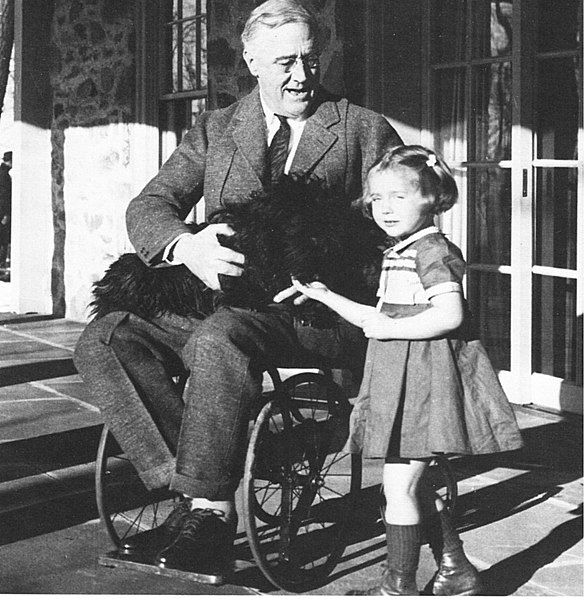 |
| Photo taken from Wikicommons |
Last week this blog described polio, the devastating disease that infected millions of children around the country during the early 20th Century. But the fact is, it didn't always hit children. The most famous person to contract infantile paralysis was a 39-year-old adult -- Franklin Roosevelt.
Roosevelt was enjoying the summer of 1921 at his family's cottage on Campobello Island in New Brunswick, Canada when the symptoms started. In a matter of a couple days, he went from having back pain and weakness in his legs to being paralyzed from his waist down and in agony.
His wife Eleanor, seeing him in pain, contacted the best doctors to diagnose his problem. In August, 1921, Dr. Robert Lovett finally diagnosed him with infantile paralysis after several wrong diagnoses by others. Franklin and his wife were stunned by the verdict since adults were not known to contract polio.
 He dropped out of political life to try to deal with the debilitating disease. By the fall, the disease had run its course and Franklin was left with the process of rehabilitation. He must have been wondering if would he ever be able to walk again. He found that swimming helped to strengthen his arms and stomach muscles. He spent hours a day in the pool because it temporarily gave him a feeling of independence.
He dropped out of political life to try to deal with the debilitating disease. By the fall, the disease had run its course and Franklin was left with the process of rehabilitation. He must have been wondering if would he ever be able to walk again. He found that swimming helped to strengthen his arms and stomach muscles. He spent hours a day in the pool because it temporarily gave him a feeling of independence.In early 1922 his legs were fitted for braces because they were so weakened from the disease. With much hard work and exercise, he was able to stand with assistance by spring.
When he heard that the "healing waters" of Warm Springs, Georgia had cured another polio victim, he headed south to see if that would work for him in 1924. The waters did not cure him, but he continued to visit Warm Springs for the rest of his life for rehabilitation.
After years of exercise and therapy, he was able to walk with braces on his legs for short distances. His wife persuaded him to re-enter the political arena by 1928 knowing that he'd have to live with his disability for the remainder of his life.
He was elected governor of New York in 1928, proving that his handicap did not affect how the voters viewed him. He was elected twice as governor before running for president in 1932. This was before the days of television, so the general public never really knew that he had a disability. They only knew him through his voice on the radio, never realizing that he was speaking from a wheelchair.
 |
| Chatting with another polio victim |
He requested that the press would only take photographs of him while he was sitting or from the waist up. He didn't want people to see that he was wheelchair bound most of the time. With the help of his braces, he was able to stand and walk with assistance on some occasions.
He did use the "bully pulpit" to bring awareness to the fight against polio. In 1938 he urged the citizens of the country to donate to the National Foundation for Infantile Paralysis to help in research against this disease. This foundation, later renamed the March of Dimes, raised one million dollars which helped to develop the Salk vaccine to fight polio.
Until researching for this topic, I never realized that Roosevelt suffered from polio. He didn't waver from his goals even after he was afflicted with this terrible disease. That takes great amounts of courage and fortitude.
I may not agree with his political ideology, but I do admire him for the courageous way he faced life every day with this handicap. We often give up with small hurdles to cross, but Roosevelt never gave up during the darkest days of the Great Depression, Pearl Harbor, and the following years of World War II.
Do you have someone that you admire who has overcome an impossible situation?
Information taken from FDR Library - about polio
No comments:
Post a Comment